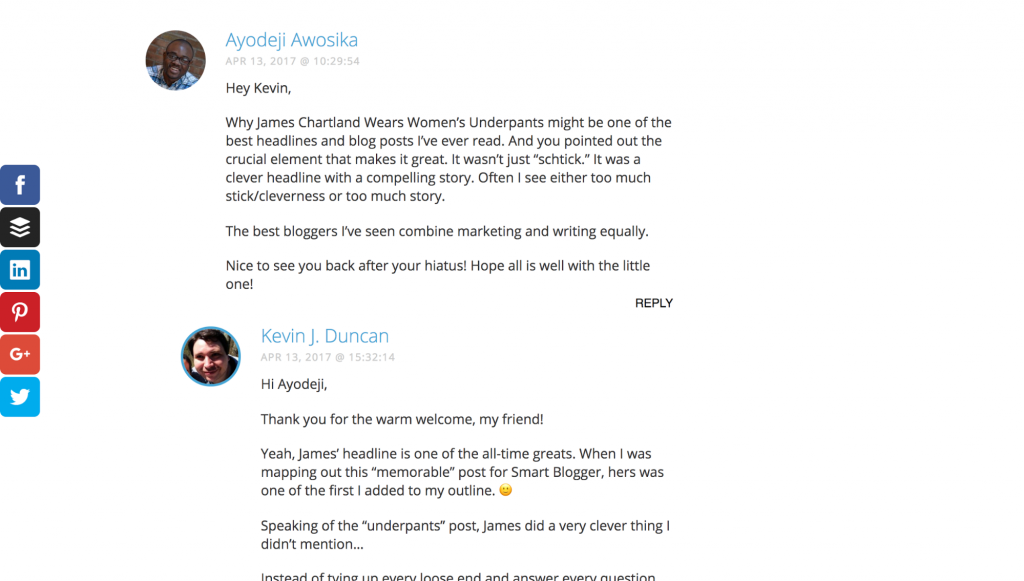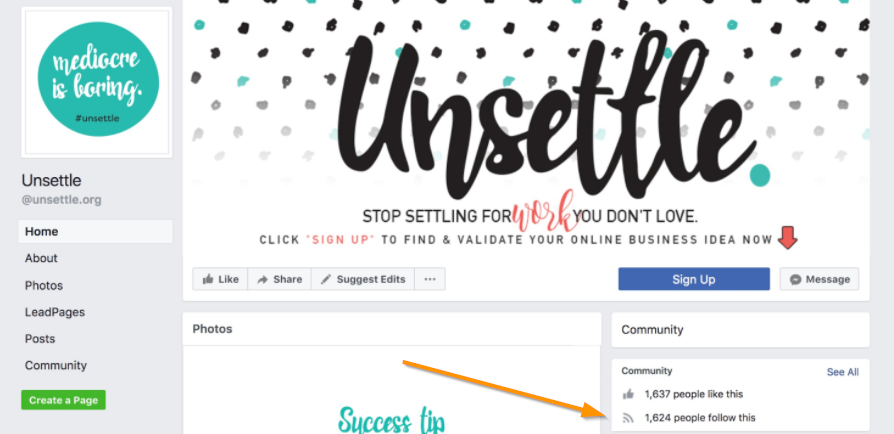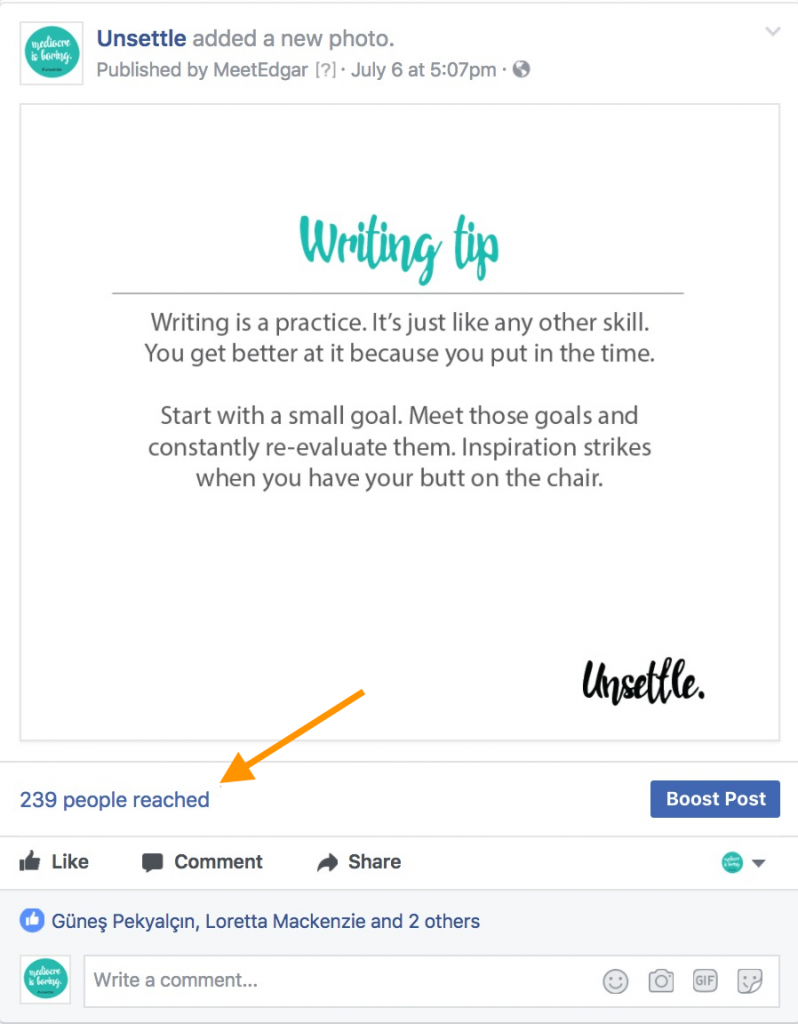You feel misguided.
When you started your blog, you thought you could just follow in the footsteps of your favorite blogger, right? Just publish great content and maybe spend some time on social media and you thought the readers would come.
But in reality, you find yourself grinding.
You stay up late after your 9-5 to write articles. You hustle for every single visitor. And you feel as if you’re spinning your wheels in a rut, not getting anywhere with your blog.
You wonder if it’s your writing. You wonder if it’s your topic. You wonder if maybe blogging just doesn’t work anymore.
But I have good news for you:
It’s not blogging that doesn’t work anymore. It’s these old-school blogging tactics that somehow still pop up online as effective methods of growing your blog.
Instead of throwing in the towel on blogging completely, throw in the towel on these outdated strategies and start upping your game (and your traffic) with what works today.
Tactic #1: Hoping “Great Content” Will Save Your Sorry Ass
You’ve been told that “content is king” and “if you build it, they will come.”
So you’ve spent countless hours building a hub of awesome content on your topic, and you just know it’s what your target audience is looking for.
Once upon a time, that might’ve been enough. People would’ve found you and spread the word about you.
But these days, everyone is writing amazing content. There are hordes of carefully crafted, ruthlessly researched, expertly written blog posts on every topic.
Readers won’t come looking for you. You need to go looking for them. You can’t do that if all you do is write, write, write.
What to Do Instead
Instead of spending all your time writing and publishing content, you need to spend more time getting that content in front of readers.
In fact, Derek Halpern suggests you should only spend 20% of your time creating great content, and 80% of your time promoting it.
So build relationships with influencers. Develop an outreach strategy to get links and shares. Repurpose your articles for maximum exposure.
If you don’t, it won’t matter how amazing your content is; you’ll keep struggling to build an audience.
Tactic #2: Guest Blogging on Huge Media Sites for Traffic
It was July 2015, and I was so excited.
I had only launched Unsettle six months prior and Huffington Post accepted me as a contributor.
So I got to work. I researched Huffington Post’s business section to find the perfect topic. I stayed up late to write an article that I thought would resonate. Then I logged into my contributor dashboard, loaded the article, and pressed “publish.”
The next morning, I woke up early, excited to check my stats, and … crickets. I saw maybe 20 visitors from the article I’d worked so hard to write.
What happened?
The problem is that these huge media publications keep on growing in size and staff. And the more they grow, the less chance you have of drawing significant traffic from them. After all, it’s much harder to stand out when they publish thirty or more posts alongside yours.
Sure, if they happen to feature your post prominently on their front page, you may go viral and draw more traffic than you can handle. But you’re more likely to lose the traffic lottery than win it.
When it comes to guest blogging, you have much more reliable options.
What to Do Instead
Guest blogging is still hugely beneficial for bringing in traffic, email subscribers, and social proof.
But instead of targeting huge media sites like Huffington Post, you should target more specific, topic-based blogs. For example,if you’re a finance blogger, instead of guest blogging on MSN Money, you would target Budgets Are Sexy or The Penny Hoarder.
These blogs usually have large, engaged audiences specific to your topic.
Also, these kinds of blogs are often run by a single influencer. Guest blogging for them will help build your relationship, which can lead to them sharing your posts in the future. (This could end up sending you more traffic than the guest post itself.)
As for those huge media sites, the only reason to write for them is if you’d like to add your logo to your “featured on” list. You may not get a ton of traffic, but having written for these big websites does lend you credibility in the minds of many readers.
Tactic #3: Asking Readers to “Subscribe for Free Updates.” (Is It 2009?)
Listen, you can no longer expect people to give you their email in return for “free updates” or your “free newsletter.”
Yes, you’re supposed to grow your email list, but if you’re asking for emails without giving anything in return, you’re ignoring an important psychological societal norm: reciprocity.
This tactic may have worked in the past, but everybody knows the power of email marketing today, so every blog, website, and shop is vying for your visitor’s email address. You’ll see pathetic opt-in rates if you’re not offering anything concrete.
What to Do Instead
Instead of just asking outright for email addresses and hoping your readers are generous enough to cough them up, you need to give them something valuable in return.
That means creating an opt-in offer your visitors can’t refuse.
An opt-in offer is a free resource you provide related to your topic that you give away in exchange for an email address to incentivize email subscriptions (and rapidly grow your email list).
With the right opt-in offer, you’ll see your subscription rate go from a measly 1%–2% to an encouraging 5% or more.
Tactic #4: Trying to Build an Ad-Driven Media Empire
Back before the days of affiliate marketing and product creation, there were the days of advertising — one of the only ways bloggers of yesteryear could begin to monetize.
The idea was that you’d build a huge site with lots of pages ranking in Google, slap ads on them, and you’d see profit.
Now, even back in the day, the gains you’d get from ads were modest. Even then, you’d need a whole lot of people clicking your ads to make a decent living. But if you had enough pages ranking for profitable keywords, you could make it work.
These days, it’s even harder than it was before. Not only do you face a lot more competition, but most people have developed “banner blindness,” which means they pay so little attention to the ads on a page that they don’t even notice them.
Advertising is an ineffective (and unprofitable) means of monetizing your blog. Fortunately, you have much better options.
What to Do Instead
Blogging is more of a viable career than ever before.
But now, instead of relying on tacky display ads to earn you pennies for the hard work you do, you can earn much more by creating products, offering services, or selling online resources and courses.
Turn toward treating your blog as an actual business, and away from scammy monetization practices like advertising.
Tactic #5: Lurking in Comments Sections Looking for Traffic
Back in the day, the way to guarantee traffic was to leave comments on articles posted on other blogs in your niche.
If you left your comments in enough places, they could bring you significant amount of traffic. You’d just leave a link in the URL section of your comment, and wait for the traffic to roll in.
Why do you think you still see so much spam in comment sections? Because this used to work like gangbusters.
But now this no longer works. Nobody has time to comb through the comments section of an article and click the links to see if commenters have a blog they might want to follow.
What to Do Instead
Commenting on other people’s blogs is still an effective way to build relationships with other bloggers. If you connect with other bloggers in their comment sections enough, they learn your name and will recognize you.
Then, if you want to send them a pitch, or a link or share request, they will already have warmed to you. They will be a lot more receptive.
Of course, leaving half-hearted comments (“Nice article!” “I totally agree with your fifth point!”) isn’t the way to do it. You’ll actually have to read their articles and share which insights you gained from it, and if you have any additional ones to offer, mention those too. (Just make sure you don’t outright contradict them, if you want to build up your relationship with them.)
You want to be more like this:
Tactic #6: Writing Y.A.R.P (Yet Another Roundup Post)
It seems as if every time you open your browser, you see another headline like this:
“32 Productivity Experts Reveal Their Morning Routines!”
This type of post is called a roundup post, where the blogger has reached out to several influencers and bloggers, asking them the same question to use their answers in an article.
This used to be an excellent strategy for getting your blog on the map. The influencers who contributed would get a backlink and a feature on your blog, and in turn they’d share the article with their social media followers.
But because they worked so well, everybody started doing them. So influencers’ inboxes are now flooded with the same old roundup questions from everybody and their dog. If they even respond with an answer (because a link is a link), they’re far less likely to share it today.
What to Do Instead
Featuring influencers in your niche is still a good way to put your blog on the map. Instead of asking a generic question and making a list post out of the answers, you can take one of two other approaches:
- Using influencers as case-study-style examples (without bothering them for their input). This is what I did with my Buffer guest post that ended up being one of the top pieces of content on the Buffer blog that year.
- Getting extremely creative and interesting with your question. Instead of just asking what the influencer’s favorite superfood is, get more creative to capture their interest and rise above the rest of the roundup questions in their inboxes. Bonus: this also appeals to more readers.
Both of these options allow you to reap the benefits of a roundup post without ending up on influencers’ hit lists (or being completely ignored).
Tactic #7: Writing for Rankings (Rather Than Readers)
Not that long ago, bloggers could “game” the search engines.
You could write short, keyword-rich articles for your blog and actually rank. The more content you published, the more keywords you had the opportunity to rank for.
In fact, I wrote a blog called Suburban Finance, and because I wrote several articles about buying a house, I ranked in the top 50 for the search term “house.”
True story.
But since then, Google’s algorithm has become much more savvy.
See, Google’s business model relies on its users getting the search results they want — relevant, valuable content about whatever topic they’re searching for. So instead of valuing content based on quantity, Google uses measures of quality.
That means that it looks at factors like:
- “Dwell time” (how long a user will spend on the page)
- Bounce rate (the percentage of users who leave your site after visiting one page)
- Content richness (the length and depth of the search result)
These factors all show Google (and other search engines, not that they matter) that the result they displayed to their user was relevant and valuable.
What to Do Instead
Cranking out five 300-word blog posts per week so you can rank does not lead to relevant or valuable content.
Instead of becoming a content mill, hoping to rank for keywords, focus on creating quality content for the keywords you’re looking to rank for.
You must write for people. And people are looking for answers. When you write detailed, long-form content, it is more likely to have the answers they seek.
Tactic #8: Being a “Jack” of All Social Platforms (Instead of a Master of One)
It used to be standard practice to have a social media presence on every platform possible to cover your bases. But that’s no longer effective.
With the introduction of algorithms for many social platforms, your posts reach fewer of your followers than ever before, so blasting your blog posts to every social media platform won’t bring you much traffic at all.
If you have 1,000 likes and follows on your Facebook page, that used to mean you promote your blog posts in front of most of those followers, but now only 6% (and often far less) of your fans will even see your posts in their newsfeeds.
Facebook isn’t the only social platform that has taken this approach. Instagram is the latest platform to follow suit.
To get your posts in front of more people on these platforms, you need to drum up engagement so the platform trusts that your followers want to see your posts.
But that’s nearly impossible to do unless you know the platform intimately and build up a strong presence. And it’s tough to do so if you are spreading yourself across every social network out there.
What to Do Instead
Focus on just one social media platform and promote your articles more heavily.
The only way to get more people to see and like your posts on social media is to develop a deeper understanding of each platform and post on a regular basis so you can conquer those prohibitive algorithms.
How regularly?
CoSchedule says that it depends on the social platform, but here’s a quick breakdown:
- Post to Facebook 1–2 times per day
- Tweet 15 times per day
- Instagram 2–3 times per day
Develop a deeper, more intimate knowledge of the social platform to truly benefit from social media marketing.
Wake Up and Ditch the Outdated Blogging Advice
I bet you’ve thought it.
I know I have.
“If only I’d started sooner.”
You know, back when professional blogging wasn’t so popular. Back when the blogosphere wasn’t more competitive than the restaurant industry. Back when all you had to do to get traffic was post on Facebook every time you published a new post.
It’s tempting to write blogging off as one of those things you had to start back before it became popular.
But I have good news …
You can still make in the blogosphere. You just have to ditch the old-school blogging tactics that no longer work and lean into the new strategies.
And sit back and watch the traffic, readers, and subscribers roll in.




